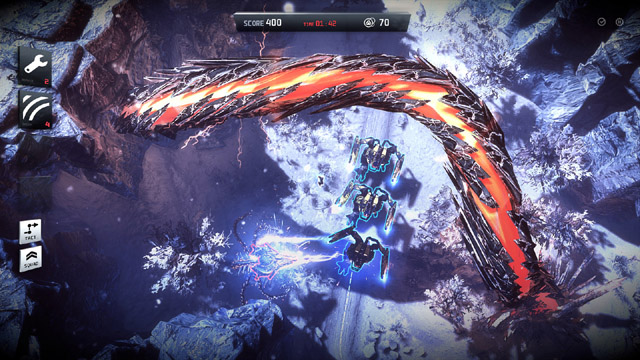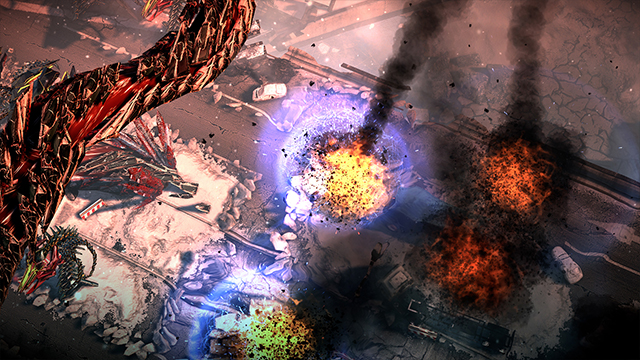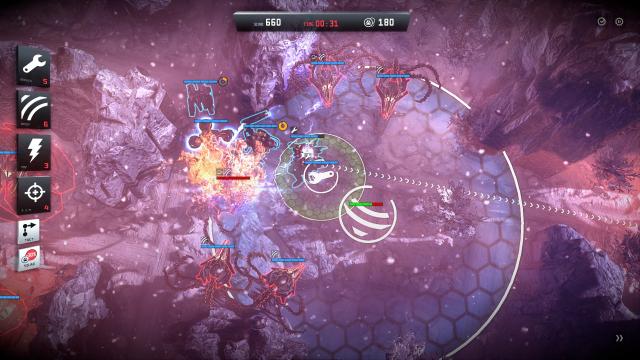Anomaly 2 Review
Anomaly 2 is an entry into the tower defence / offence genre that 11bit Studios created themselves with the critically acclaimed Anomaly: Warzone Earth; A genre that absolutely thrives on head-to-head competition. Fans will be glad to know that the spiced-up mechanics of this sequel do nothing to ruin that. Still on offer are bite-size matches that can be rapidly consumed until their sum has dissolved the entirety of an afternoon like a slow working acid.
It all begins with a tutorial mode masquerading as a campaign. Even if you rite-off the story immediately, you should give this mode a shot, as it does a fantastic job of introducing the mechanics that make Anomaly unique.

Set on a post-apocalyptic Earth, humanity struggles to find resources and develop weapons to fend off an alien invasion. Holding onto what little hope they can, survivors travel in convoys and adhere to strict military rule because, realistically, there aren’t many options. After all, Humans are now the minority to the machines that rule the planet. Best to band together.
You control Commander Yukon, leader of his own convoy amid the frozen tundra. Commander Yukon serves an important role in combat, being the only unit that can be directly manoeuvred As he runs across the battlefield, he deploys tools to assist his troops in their fight against towers.
A repair beacon will heal all units passing through its small radius for the entirety of its duration. A decoy will distract; an especially useful tool against the hulking Behemoths which are fortunately plagued by a slow rotation speed. An EMP to disable turrets and a move entitled “A.I.M” to focus and increase firepower round out the roster for the Human player.

Destroying enemy units will net resources which can be used to build units, upgrade existing units or to improve the team’s tech. Improving tech is slightly different from standard RTS faire: each tier is unlocked through purchasing from a myriad of bonuses, ranging from health and damage power ups to buffs to specific abilities. When you move up a tier, you unlock more units for your faction, an element of the tech tree will be more familiar to fans of the genre. All in all, each side has 8 units and 4 levels of tech, with 2 units unlocking per bonus.
Most of these units have an alternate mode that can be used on the fly to combat a change in circumstance. The squad’s basic unit, a rapid firing drone, typically is used at mid range in areas of heavy hostile density. This allows it to spin up its guns and keep its damage potential maximized. But if buildings interrupt your stream of bullets or towers line both sides of your path, a quick double click will transform your unit into a mechanized walker that spouts flames to either side.
Once your squad is decided on, you must guide them by re-routing their path to suit your plan, ultimately leading to the destruction of the opponent’s generator. Or, if you’re the one placing towers, the protection of your own. Obviously towers will be immobile so a degree of guesswork will be required in defending against the Squad player. From this end you realize how much the tower defence genre benefits from a human opponent.

Classic tower defence staples are in play here. You will have a harvester unit to keep your economy up in addition to units that are there to simply support or enfeeble. Harvesters easily become some of your most important units as they allow you to build an unruly bastion of Berserkers.
Due to the importance of Bersekers on the battlefield, the Squad player has plenty of incentive to destroy them. Coupled with the fact that they grant a point bonus upon their destruction to the Squad, they become a good means of bait for the more experienced players. I discovered my limits quickly and simply left them on the backline. Perceptive opponents noticed this and their confidence level seemed to increase, adding another layer of strategy to simple-yet-nuanced systems.
The first player to reach a pre-set point limit or to gain a large enough point advantage will be deemed the victor. This “mercy rule” mechanic feels a bit unnecessary and often ended my matches just as I was starting to enjoy them. Perhaps the goal is to keep better players from toying with others but a simple time limit would’ve been a more suitable alternative. These point amounts vary from map to map but are almost always quickly reached, and then it’s on to the next match. Due to the aforementioned brevity of the matches, every decision is burdened with increased significance.

For an indie title (a phrase I kind of hate using but find it’s important to note) the production level is up to a professional standard. On max settings, the explosions beautifully render enemies into beautifully-rendered smoke to be admired from a top-down perspective. The opening cinematic, which is just chock-full of over the top action that you only see in tribute to the 80’s, is particularly impressive, putting the warp mechanics of units on display.
Even the groan-inducing, high-octane cheese that passes for dialogue is handled by voice actors who come off as more than just amateurs or game designers themselves – at least, in the case of most characters. Yukon himself sounds just awful.
VERDICT: Anomaly 2 won’t be winning any awards and certainly won’t be showing up in any MLG circuits. The size of the game is small and offers little in terms of depth. Where the game does shine is in its ability to become more and more fun rematch after rematch. As sweet as it is to beat some random on the internet, the appeal of learning how a player employs the relatively small tool set over the course of rapid fire matches is just too much for me to personally resist.

GOOD. A game that scores 7/10 is worthy of note, but unworthy of fanfare. It does many things well, but only a few of them incredibly well and, despite a handful of good qualities, fresh ideas and solid mechanics, it fails to overwhelm.




